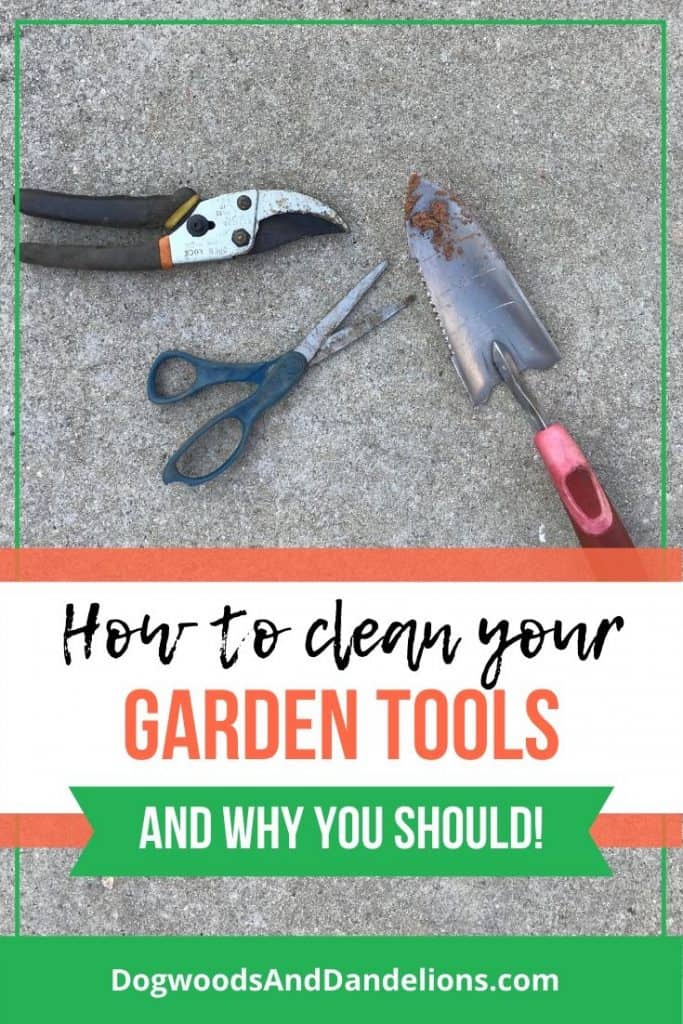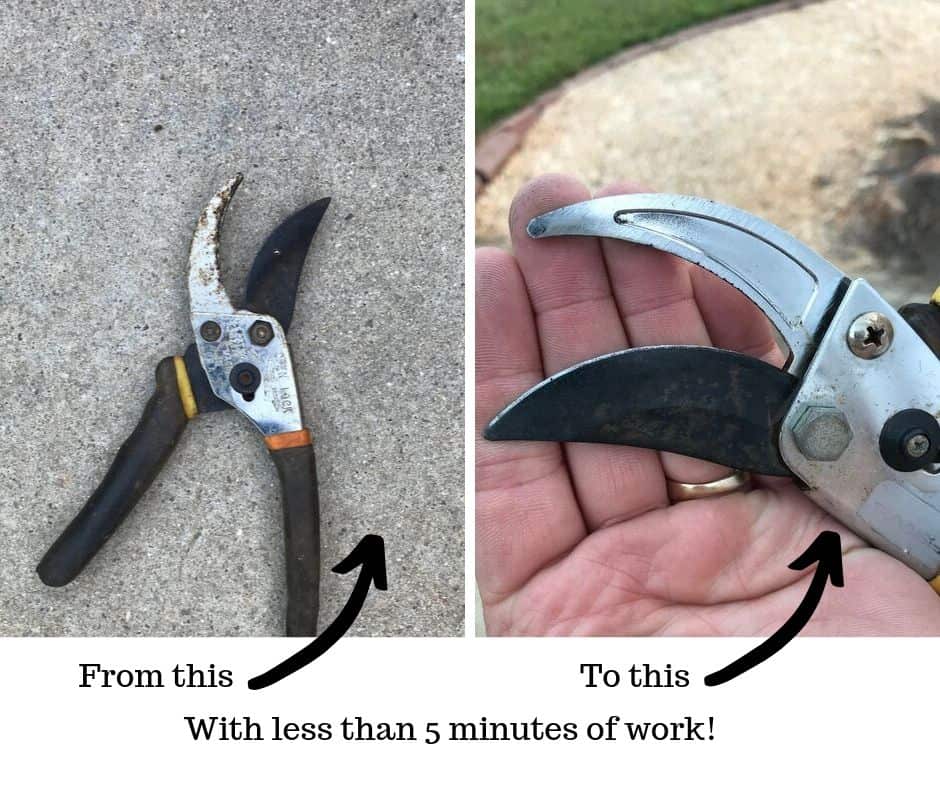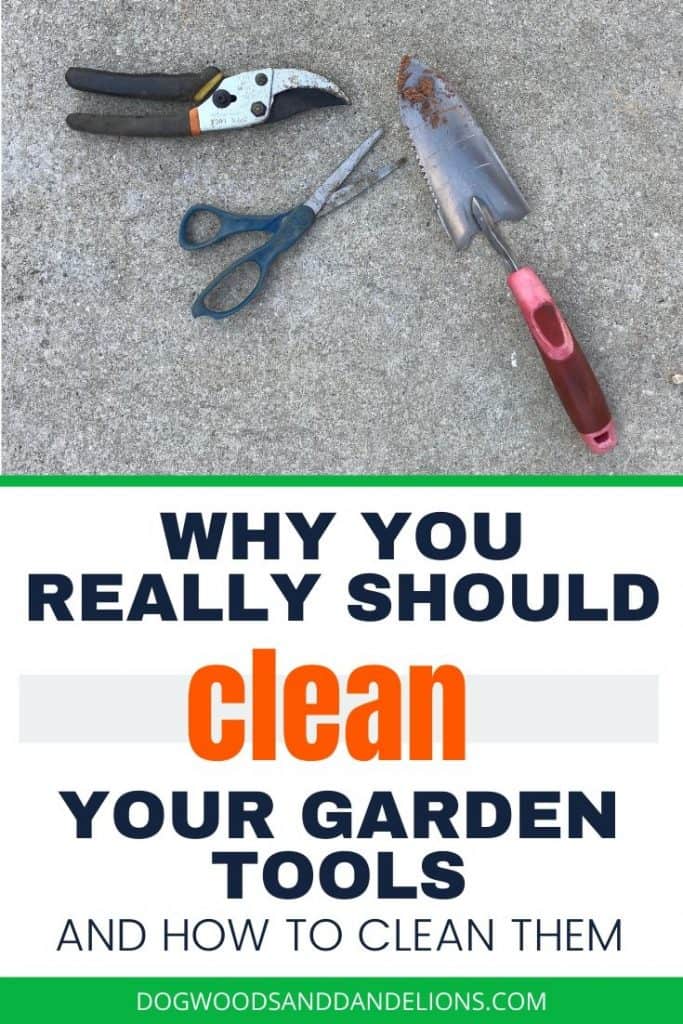How to Clean Your Garden Tools
Inside: Learning how to clean your garden tools in an important part of maintaining a healthy garden. Clean tools also make your work easier.
By the end of each garden season, garden tools usually show some signs of wear and tear. Most are dirty and pruners are usually dull and sticky. (At least mine are, anyway!)
You may think you need to purchase new ones. But, if you spent money on good quality tools, you don’t want to replace them every year or two.
However, with proper maintenance, your gardening tools can last for years and years. Cleaning your tools should be done each year as part of your fall garden cleanup or winter garden preparation.
Use these simple steps to get those tools in proper shape so when spring rolls around, you’ll be ready to jump into the garden and plant.

Affiliate Disclosure: Please note that some of the links in this article may be affiliate links and I may receive a small commission if you purchase something through a link. It will not change your cost. As an Amazon Associate, I earn from qualifying purchases. For more information, see my disclosures page.)
How to Clean Trowels, Shovels, and Rakes
To clean garden tools like trowels, shovels, and rakes, you must first remove any garden dirt. Wash the tools with warm water and dish soap.
If you’ve got rusty tools, use some medium-grit sandpaper to gently scrub the rust away.
Sharpen shovels and trowels if necessary by using a rasp . (Always wear eye protection when sharpening tools.) Try to sharpen along the same angle that the tool was previously sharpened.
It is a good idea to always store your tools in a dry place like a shed or a garage after every use. Hand tools can be stored in a bucket of sand that has been saturated with oil, while larger tools such as rakes and hoes can be hung from a board on a wall of the storage area. This will keep them cleaned and conditioned after every use.
How to Clean Pruners and Lopping Shears
Pruners and lopping shears can get dull very quickly. Tree sap and dirt can combine on your pruners to make them stiff.
This build-up doesn’t allow the pruners to cut cleanly which can stress your hands since they have to work harder. Dull, dirty pruners are also bad for your plants as they can invite disease if they don’t cut cleanly.
Furthermore, the excess build up can harbor diseases and fungus that can be transferred from one plant to another as you trim.

To Clean Hand Pruners and Lopping Shears
The first step is to remove all the dirt by scraping off what you can with a stiff brush. Then wash them in soapy water.
Next, use a wire brush or a steel wool scouring pad, and scrub the metal surfaces to remove any sticky, dried-on sap and remaining debris as well as any rust.
To sanitize the tools, wipe them down with a 10 part bleach to water solution or isopropyl alcohol. Dry the tools thoroughly with a clean cloth to prevent rust.
Sharpen pruner blades and lopping shears along the original angle by using a diamond file to renew the edge. (Again, safety glasses are a must to keep from getting debris in your eyes.)
Oil the metal parts of the tools to keep them from rusting, using the oil of your choice. Placing a drop of WD-40 or 3-in-one oil on the pivot point will keep the pruners moving parts working smoothly.
How to Maintain Wood Handles
For tools with wooden handles, the handles need to be cleaned of any dirt and debris. Allow them to dry thoroughly and wipe with boiled linseed oil.
A Note About Cleaning Garden Tools
I’ve seen many places use motor oil to wipe down their tools and keep them from rusting. I don’t really want to introduce motor oil in my garden, so I prefer to use another type of cooking oil such as olive oil or vegetable oil.

How to Store Your Garden Tools
After each use, tools such as trowels can be stored in a plastic bucket of sand mixed with some oil. The sand scrubs off the excess dirt and the oil lubricates the blades and keeps them from rusting.
This mixture should always be stored in a shed or garage so that no water is introduced into the mixture.
Other long-handled tools such as hoes, rakes, and shovels should be hung in a dry location away from the elements.
Always hang the tools by the handle, not the tool end. If a tool should fall on you, you will only get hit with the handle, not the business end of a hoe or shovel.
While they can be stored without hanging, keeping the tools off the ground keeps them from getting nicks from the floor or bumping against other tools. They will stay sharper longer and are less likely to fall.
Clean Tools Regularly
Knowing how to clean your garden tools can save lots of money in the long run. By maintaining your tools regularly, they should give you years of service so you don’t have to purchase new ones. (However, if you need a new pair of lopping shears or pruners, I highly recommend these shears and these pruners.)
Cleaning and maintaining your tools is the best way to extend the life of your garden tools. You won’t have to worry about plant diseases overwintering on your tools.
While you really should clean your tools every single time you use them, most of us just don’t have that kind of time. However, thorough cleaning at the end of the gardening season will also mean that your tools will remain in good working order and be ready to use in the spring.
Related Posts
- Fall Container Garden Vegetables
- Don’t Make These Beginner Mistakes in Your Vegetable Garden
- Grow a Deer-Resistant Vegetable Garden

Meet Julie
I’m a farm girl born and bred in North Carolina. I’ve been growing a vegetable garden for over 20 years (and helping my Mom grow hers even longer). I’ve been raising chickens in my bathtub and backyard for 12+ years. I believe that homegrown food can be made simple. Let’s get started.

